
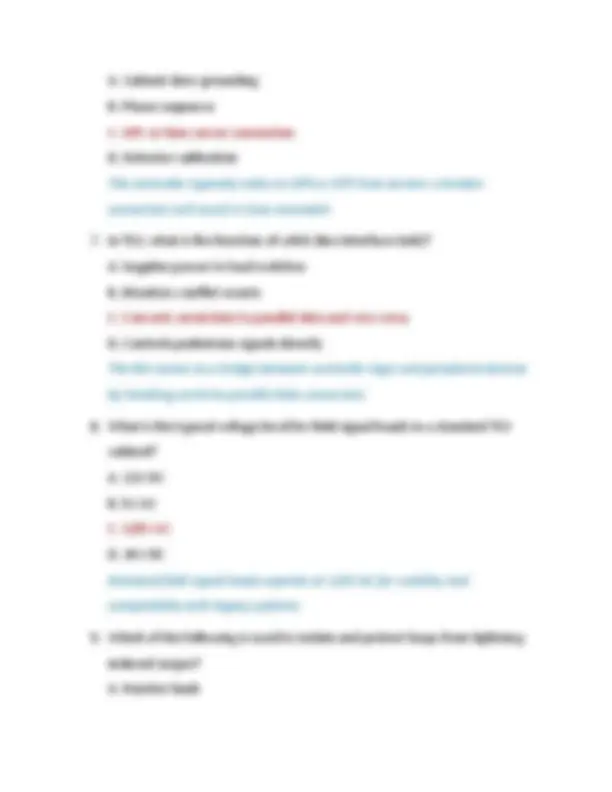
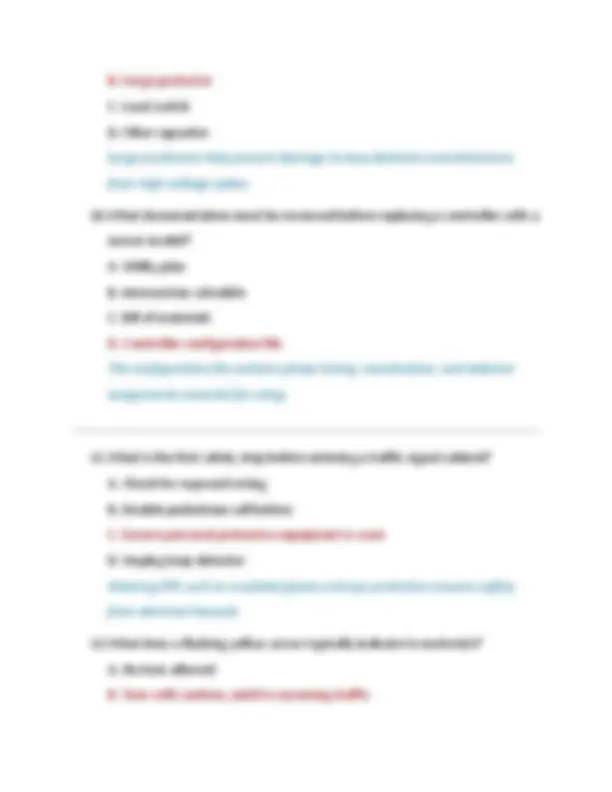
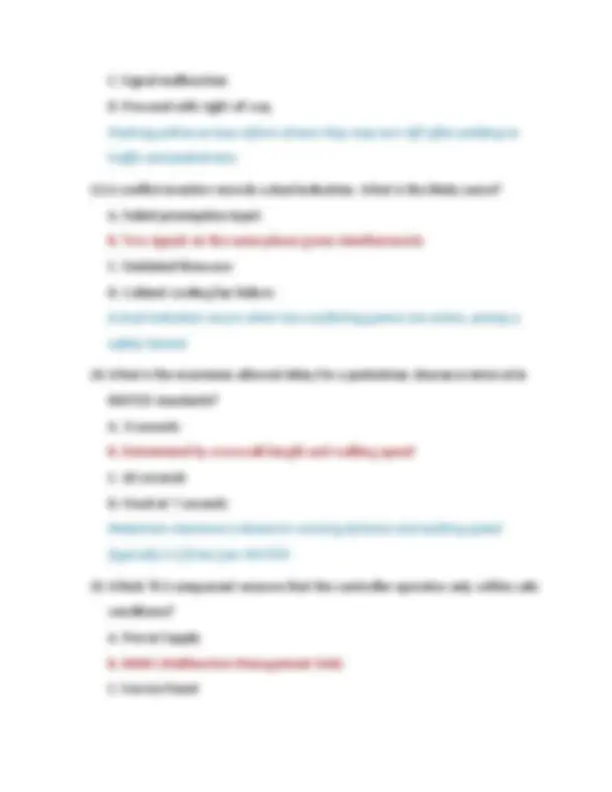
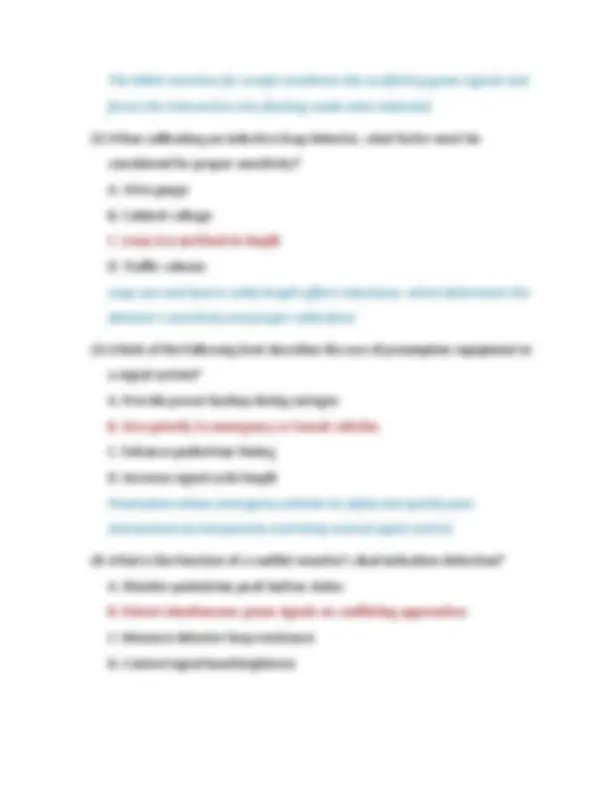
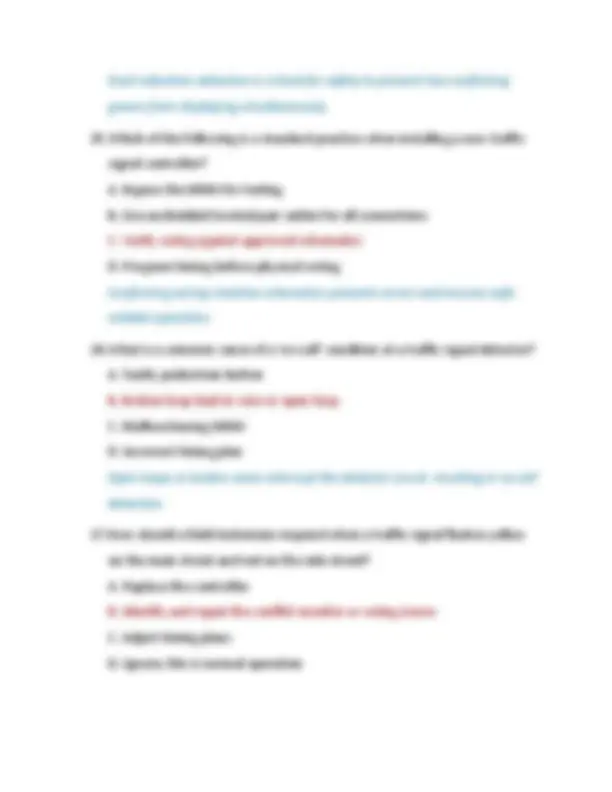
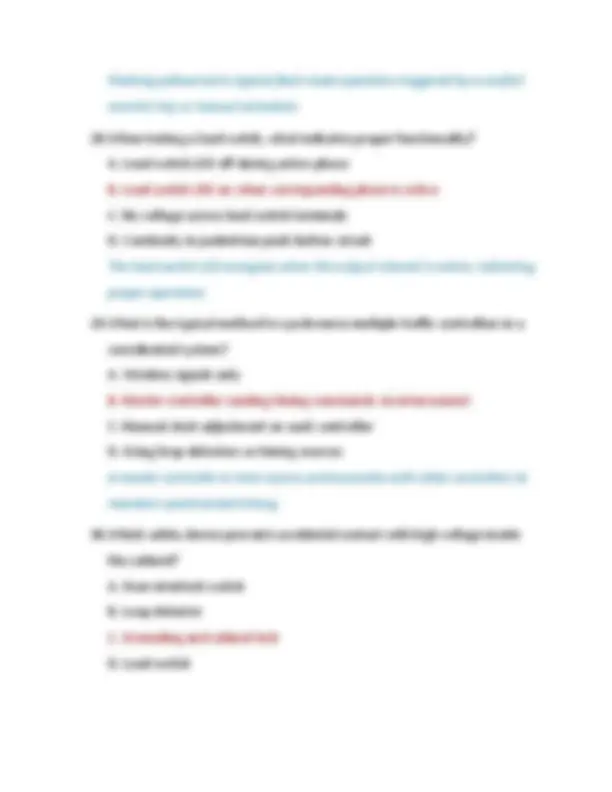
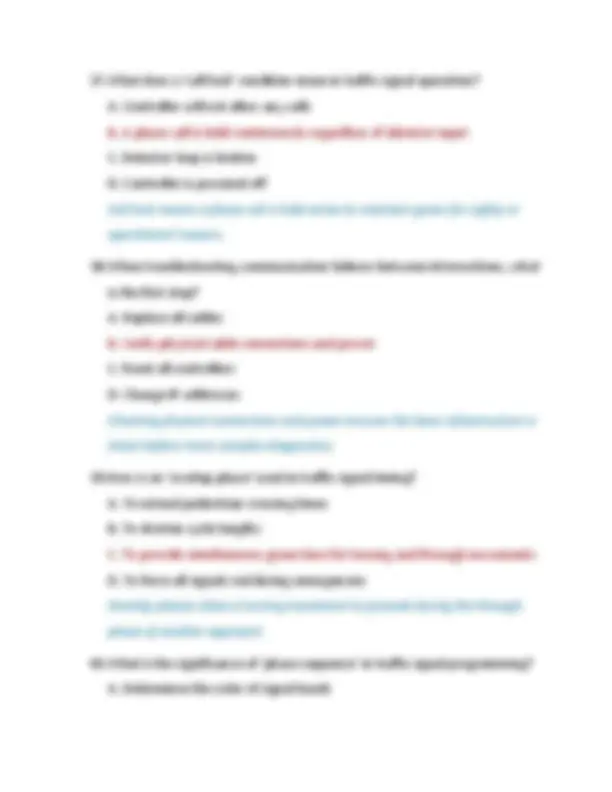
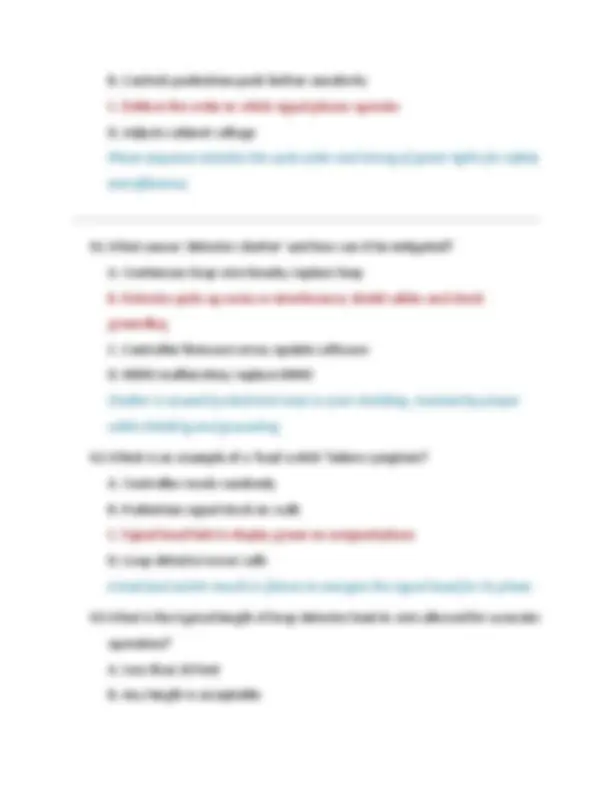
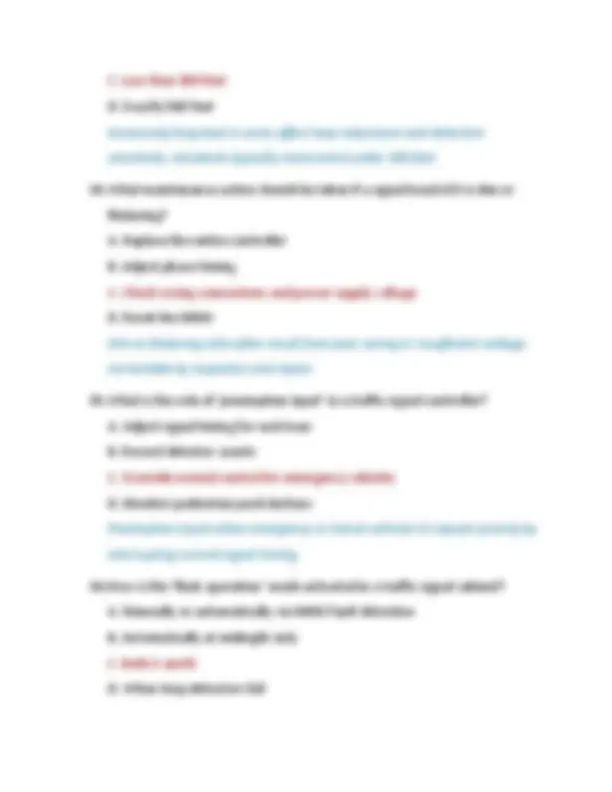
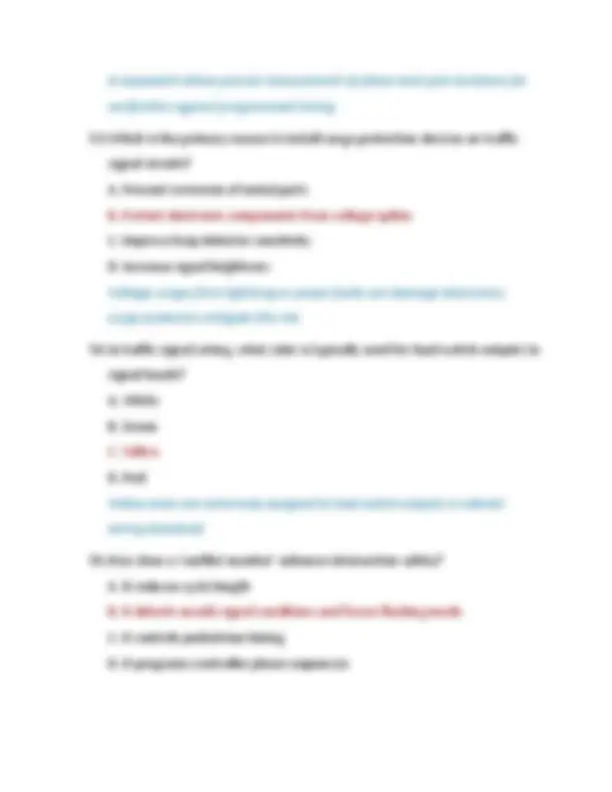
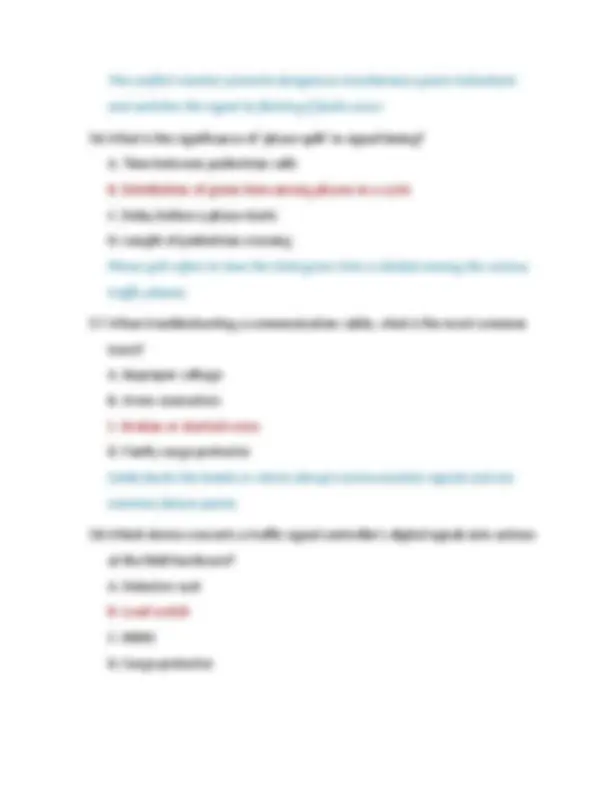

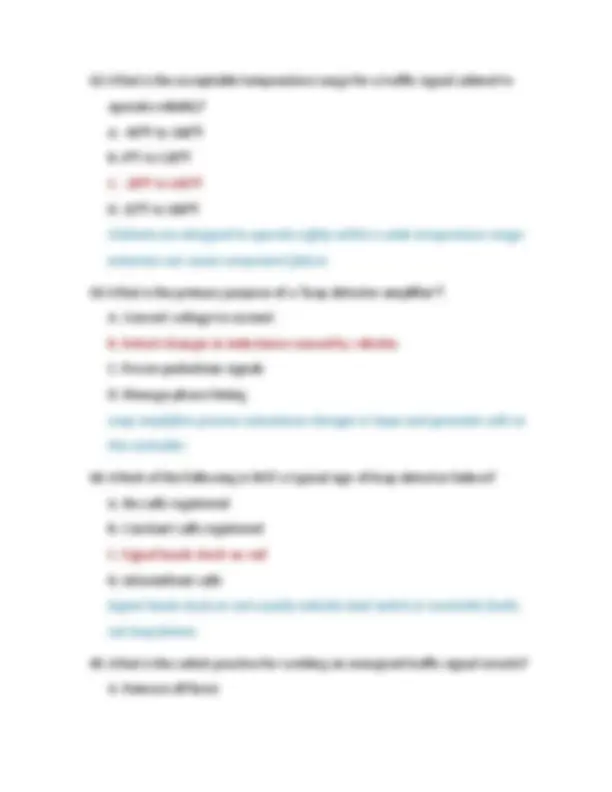
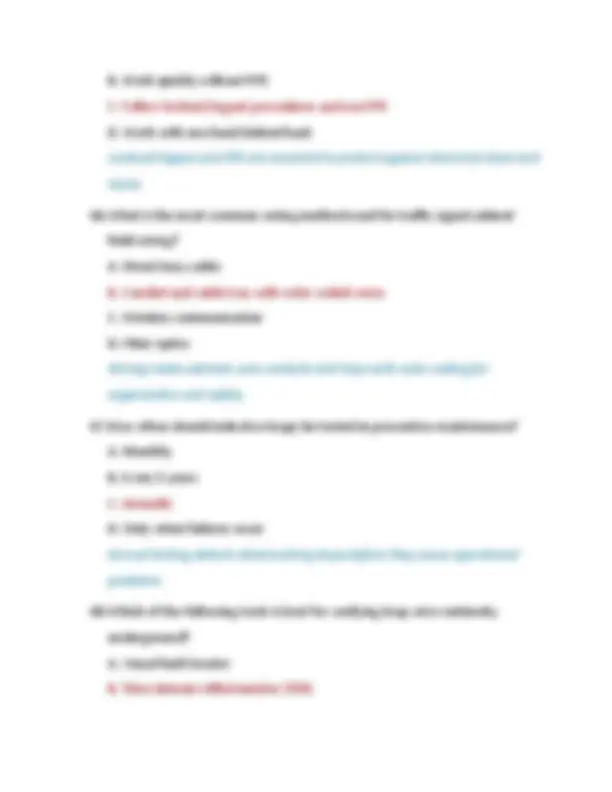
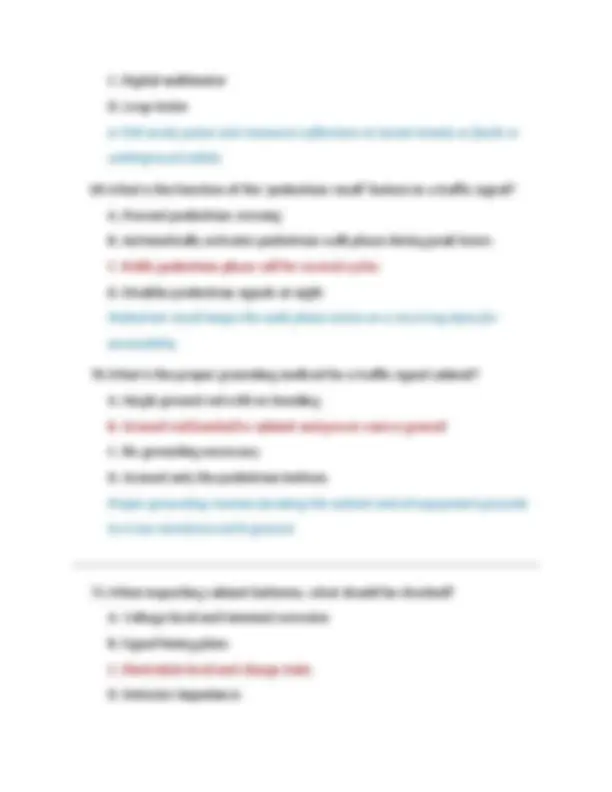
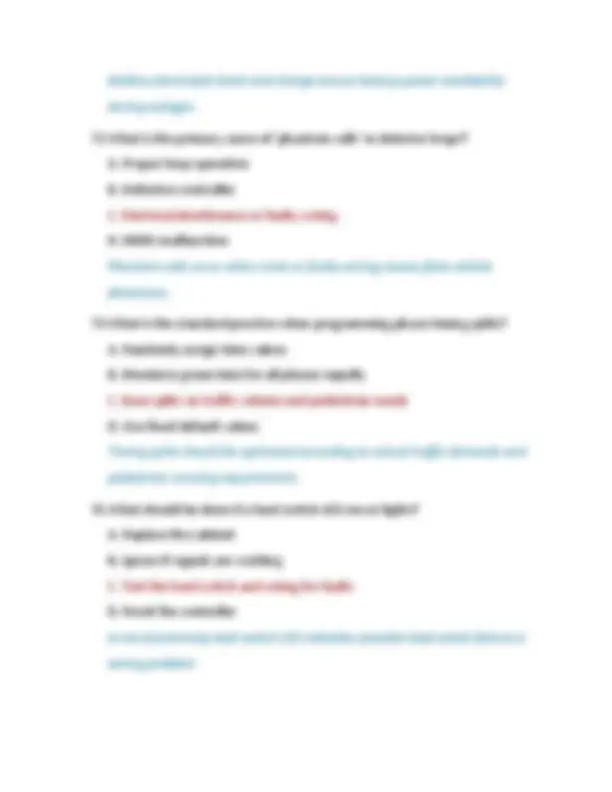
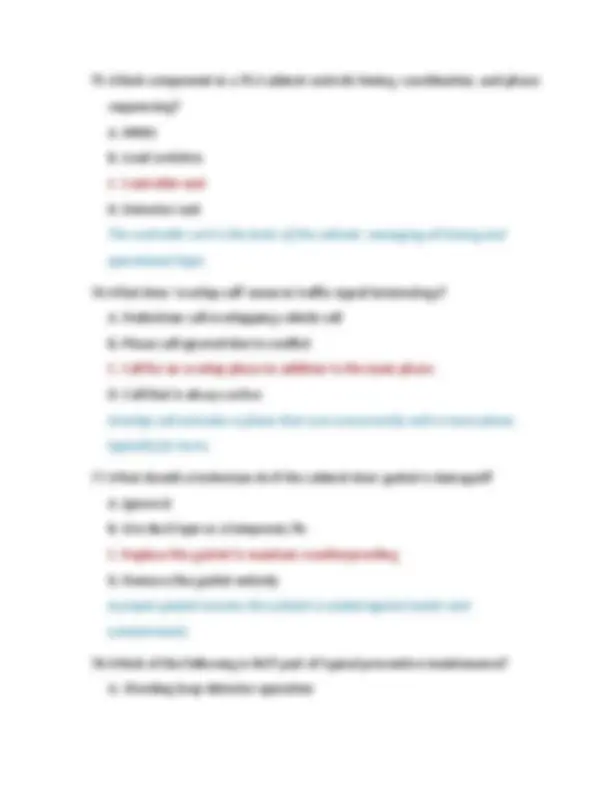
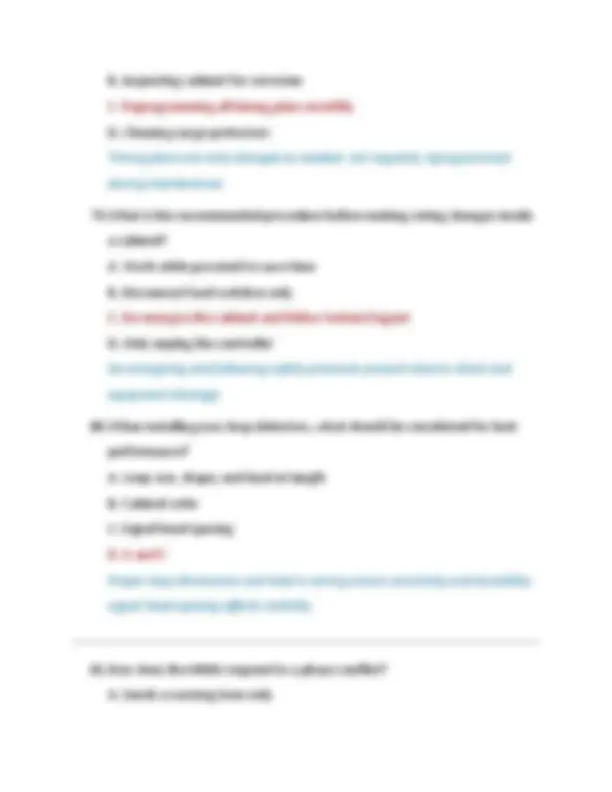
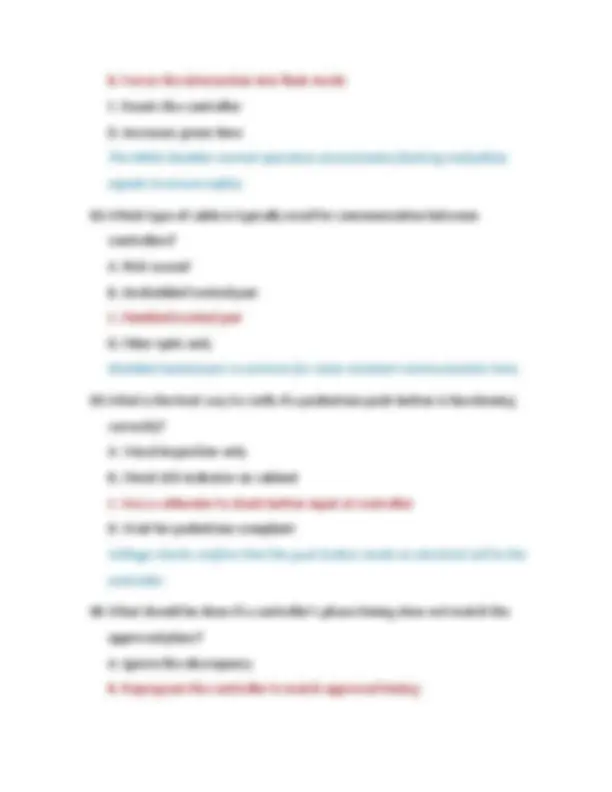
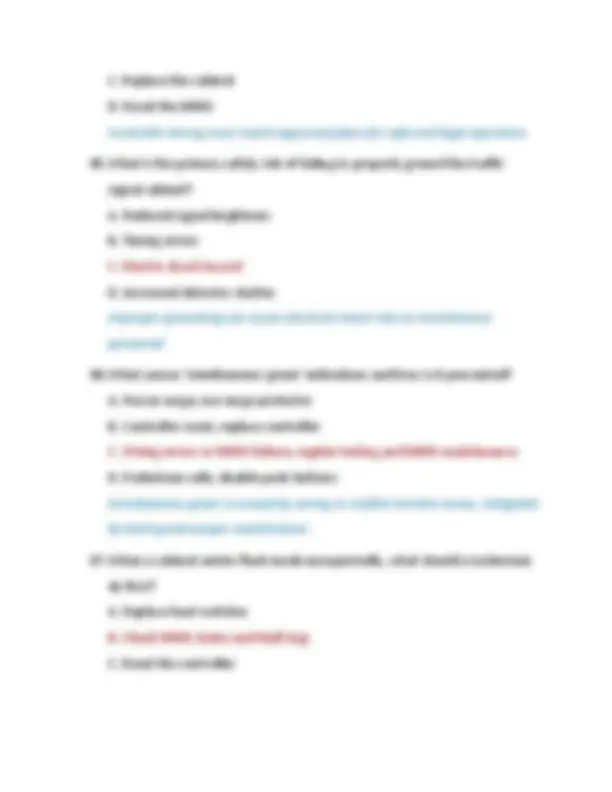
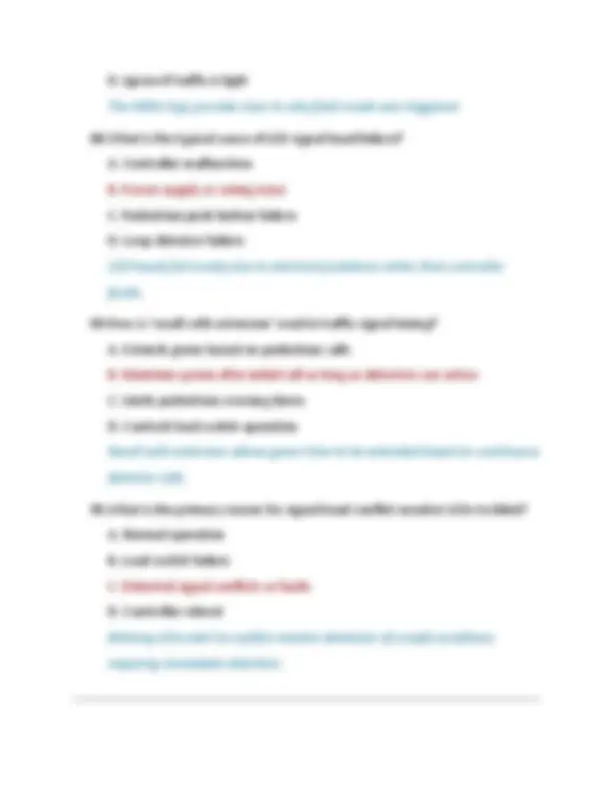
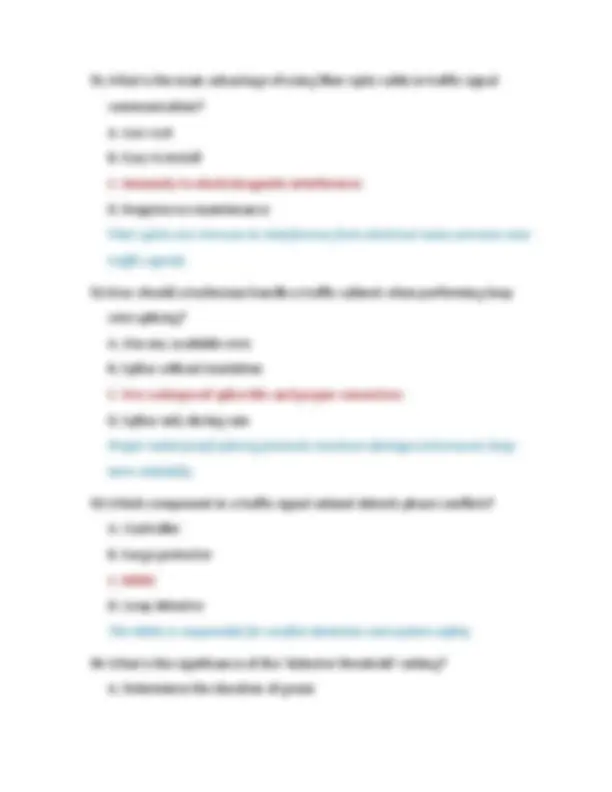
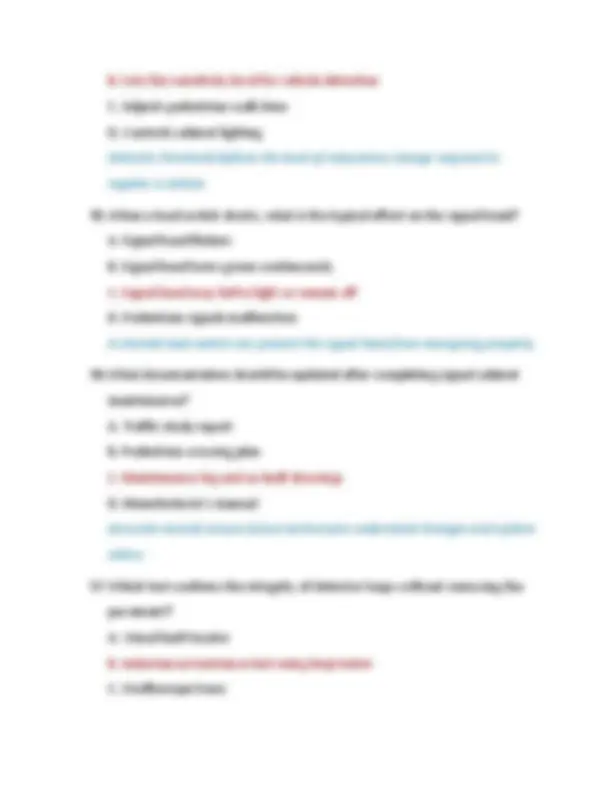
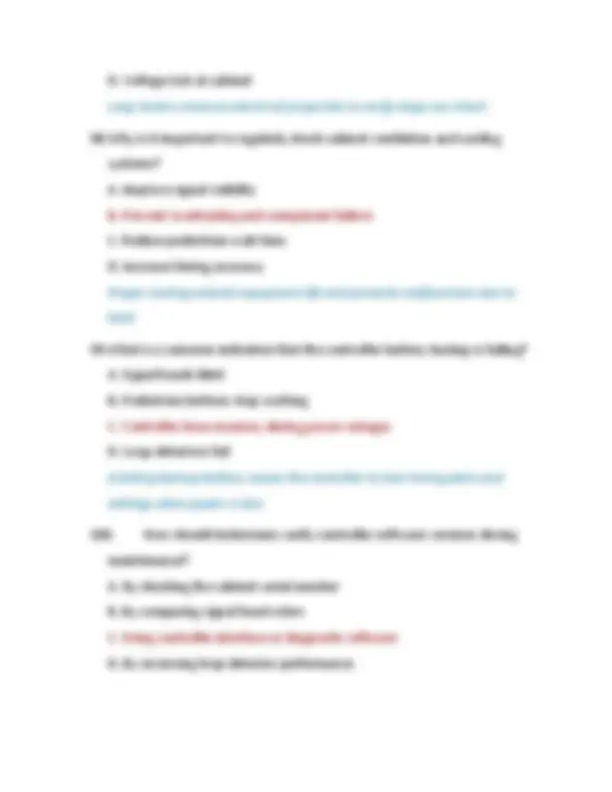



Study with the several resources on Docsity

Earn points by helping other students or get them with a premium plan


Prepare for your exams
Study with the several resources on Docsity

Earn points to download
Earn points by helping other students or get them with a premium plan
Community
Ask the community for help and clear up your study doubts
Discover the best universities in your country according to Docsity users
Free resources
Download our free guides on studying techniques, anxiety management strategies, and thesis advice from Docsity tutors
IMSA Traffic Signal Senior Field Technician III Certification Exam Questions And Correct Answers (Verified Answers) Plus Rationales 2025 Q&A | Instant Download
Typology: Exams
1 / 33

This page cannot be seen from the preview
Don't miss anything!


























A. Bus Interface Unit (BIU) B. Malfunction Management Unit (MMU) C. Input File D. Conflict Monitor The Input File in TS2 cabinets houses detector input terminals and facilitates signal transmission from loops or sensors to the controller.
B. Surge protector C. Load switch D. Filter capacitor Surge protectors help prevent damage to loop detectors and electronics from high-voltage spikes. 10.What documentation must be reviewed before replacing a controller with a newer model? A. Utility plan B. Intersection schedule C. Bill of materials D. Controller configuration file The configuration file contains phase timing, coordination, and detector assignments essential for setup. 11.What is the first safety step before entering a traffic signal cabinet? A. Check for exposed wiring B. Disable pedestrian call button C. Ensure personal protective equipment is worn D. Unplug loop detector Wearing PPE such as insulated gloves and eye protection ensures safety from electrical hazards. 12.What does a flashing yellow arrow typically indicate to motorists? A. No turn allowed B. Turn with caution; yield to oncoming traffic
C. Signal malfunction D. Proceed with right-of-way Flashing yellow arrows inform drivers they may turn left after yielding to traffic and pedestrians. 13.A conflict monitor records a dual indication. What is the likely cause? A. Failed preemption input B. Two signals on the same phase green simultaneously C. Outdated firmware D. Cabinet cooling fan failure A dual indication occurs when two conflicting greens are active, posing a safety hazard. 14.What is the maximum allowed delay for a pedestrian clearance interval in MUTCD standards? A. 3 seconds B. Determined by crosswalk length and walking speed C. 10 seconds D. Fixed at 7 seconds Pedestrian clearance is based on crossing distance and walking speed (typically 3.5 ft/sec) per MUTCD. 15.Which TS2 component ensures that the controller operates only within safe conditions? A. Power Supply B. MMU (Malfunction Management Unit) C. Service Panel
Each load switch is assigned to specific signal outputs; incorrect assignments will cause phase issues. 19.What type of wire is most commonly used for interconnect communication in twisted pair systems? A. RG6 coaxial B. 600V shielded twisted pair C. Fiber optic strand D. Copper bus bar Twisted pair cables with shielding help prevent interference in analog/digital communications. 20.Which piece of test equipment would best check fiber optic continuity? A. Oscilloscope B. Volt-ohm meter C. Visual fault locator D. TDR A visual fault locator (VFL) uses light to identify breaks or loss in fiber cables. 21.What is the primary function of a Malfunction Management Unit (MMU) in a traffic signal cabinet? A. Control pedestrian push buttons B. Detect signal conflicts and enforce flash operation C. Manage loop detector inputs D. Program timing plans
The MMU monitors for unsafe conditions like conflicting green signals and forces the intersection into flashing mode when detected. 22.When calibrating an inductive loop detector, what factor must be considered for proper sensitivity? A. Wire gauge B. Cabinet voltage C. Loop size and lead-in length D. Traffic volume Loop size and lead-in cable length affect inductance, which determines the detector’s sensitivity and proper calibration. 23.Which of the following best describes the use of preemption equipment in a signal system? A. Provide power backup during outages B. Give priority to emergency or transit vehicles C. Enhance pedestrian timing D. Increase signal cycle length Preemption allows emergency vehicles to safely and quickly pass intersections by temporarily overriding normal signal control. 24.What is the function of a conflict monitor’s dual indication detection? A. Monitor pedestrian push button status B. Detect simultaneous green signals on conflicting approaches C. Measure detector loop resistance D. Control signal head brightness
Flashing yellow/red is typical flash mode operation triggered by a conflict monitor trip or manual activation. 28.When testing a load switch, what indicates proper functionality? A. Load switch LED off during active phase B. Load switch LED on when corresponding phase is active C. No voltage across load switch terminals D. Continuity in pedestrian push button circuit The load switch LED energizes when the output channel is active, indicating proper operation. 29.What is the typical method to synchronize multiple traffic controllers in a coordinated system? A. Wireless signals only B. Master controller sending timing commands via interconnect C. Manual clock adjustment on each controller D. Using loop detectors as timing sources A master controller or time source communicates with other controllers to maintain synchronized timing. 30.Which safety device prevents accidental contact with high voltage inside the cabinet? A. Door interlock switch B. Loop detector C. Grounding and cabinet lock D. Load switch
Proper grounding and locking mechanisms prevent electrical shock and unauthorized cabinet access. 31.What type of timing plan adjusts signal timing based on real-time traffic data? A. Fixed time B. Pretimed C. Actuated D. Manual override Actuated timing adapts green times based on detector calls to optimize traffic flow. 32.In an advanced traffic signal system, what does ATMS stand for? A. Automated Traffic Maintenance System B. Advanced Timing Management Signal C. Advanced Traffic Management System D. Active Timing Monitoring Software ATMS refers to computer-based systems that control and coordinate traffic signals and devices. 33.How often should traffic signal cabinets be inspected for preventive maintenance? A. Every 10 years B. Annually or biannually C. Only after failures D. Every month
37.What does a ‘call lock’ condition mean in traffic signal operation? A. Controller will not allow any calls B. A phase call is held continuously regardless of detector input C. Detector loop is broken D. Controller is powered off Call lock means a phase call is held active to maintain green for safety or operational reasons. 38.When troubleshooting communication failures between intersections, what is the first step? A. Replace all cables B. Verify physical cable connections and power C. Reset all controllers D. Change IP addresses Checking physical connections and power ensures the basic infrastructure is intact before more complex diagnostics. 39.How is an ‘overlap phase’ used in traffic signal timing? A. To extend pedestrian crossing times B. To shorten cycle lengths C. To provide simultaneous green time for turning and through movements D. To force all signals red during emergencies Overlap phases allow a turning movement to proceed during the through phase of another approach. 40.What is the significance of ‘phase sequence’ in traffic signal programming? A. Determines the color of signal heads
B. Controls pedestrian push button sensitivity C. Defines the order in which signal phases operate D. Adjusts cabinet voltage Phase sequence dictates the cycle order and timing of green lights for safety and efficiency. 41.What causes ‘detector chatter’ and how can it be mitigated? A. Continuous loop wire breaks; replace loop B. Detector picks up noise or interference; shield cables and check grounding C. Controller firmware error; update software D. MMU malfunction; replace MMU Chatter is caused by electrical noise or poor shielding, resolved by proper cable shielding and grounding. 42.Which is an example of a ‘load switch’ failure symptom? A. Controller resets randomly B. Pedestrian signal stuck on walk C. Signal head fails to display green on assigned phase D. Loop detector never calls A bad load switch results in failure to energize the signal head for its phase. 43.What is the typical length of loop detector lead-in wire allowed for accurate operation? A. Less than 10 feet B. Any length is acceptable
Flash mode can be activated manually by technicians or automatically if a fault is detected by the MMU. 47.What is the effect of incorrect phase termination wiring? A. Signal heads may display conflicting greens B. Pedestrian signals turn off C. Controller may skip phases or fail to operate properly D. Cabinet will lose power Wrong termination can cause the controller to misread calls and skip phases. 48.What is a ‘call-on-detector’ feature? A. Pedestrian push button override B. Emergency vehicle priority C. Automatic phase call based on detector input D. Manual controller override Call-on-detector means the controller registers a phase call automatically when a detector is activated. 49.What is the purpose of ‘hand time’ in pedestrian signal timing? A. Time before pedestrian signal activates B. Interval when the pedestrian “don’t walk” signal flashes C. Total crossing time D. Time to adjust traffic phases Hand time is the flashing “don’t walk” phase allowing pedestrians already in the crosswalk to finish crossing safely.
50.When conducting a cabinet ground resistance test, what is the acceptable resistance level? A. Less than 100 ohms B. Exactly 50 ohms C. Less than 5 ohms D. More than 10 ohms A low resistance ground (<5 ohms) ensures effective dissipation of electrical faults for safety. 51.What is the typical cause of a ‘phase failure’ alarm in a traffic signal controller? A. Excessive pedestrian calls B. Power surge in cabinet C. Load switch failure or open wiring in phase circuit D. Improper controller timing Phase failure alarms generally indicate that a phase did not energize correctly, often due to load switch or wiring faults. 52.What tool is best used to verify timing accuracy of a traffic signal controller? A. Loop tester B. Oscilloscope C. Stopwatch or timing device D. Spectrum analyzer
The conflict monitor prevents dangerous simultaneous green indications and switches the signal to flashing if faults occur. 56.What is the significance of ‘phase split’ in signal timing? A. Time between pedestrian calls B. Distribution of green time among phases in a cycle C. Delay before a phase starts D. Length of pedestrian crossing Phase split refers to how the total green time is divided among the various traffic phases. 57.When troubleshooting a communication cable, what is the most common issue? A. Improper voltage B. Worn connectors C. Broken or shorted wires D. Faulty surge protector Cable faults like breaks or shorts disrupt communication signals and are common failure points. 58.Which device converts a traffic signal controller's digital signals into actions at the field hardware? A. Detector rack B. Load switch C. MMU D. Surge protector
Load switches receive controller outputs and power the corresponding signal heads or devices. 59.What action should be taken if a controller loses power unexpectedly? A. Replace the cabinet B. Check power source, fuses, and circuit breakers C. Adjust timing plans D. Recalibrate detectors Power loss often results from supply issues; these must be verified before further troubleshooting. 60.What is the function of ‘recall’ in traffic signal controller operation? A. Reset the controller B. Maintain green time when no calls are present C. Cancel pedestrian calls D. Activate preemption Recall allows a phase to retain green even if no new detector calls are received, useful for arterial coordination. 61.What is a ‘conflict zone’ in a traffic signal controller? A. Area where pedestrians cross B. Set of conflicting phases monitored by the MMU C. Detector wiring area D. Cabinet grounding zone Conflict zones define which phases cannot be green simultaneously and are monitored for safety.